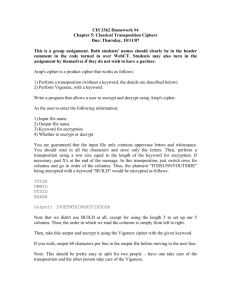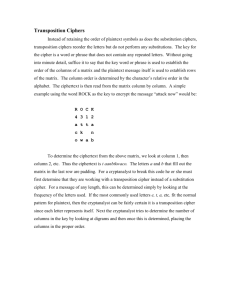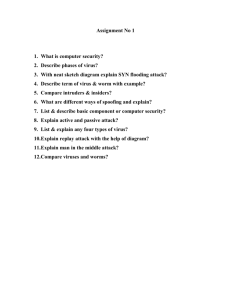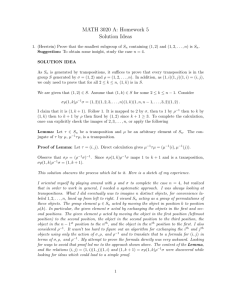transmission line transposition
advertisement
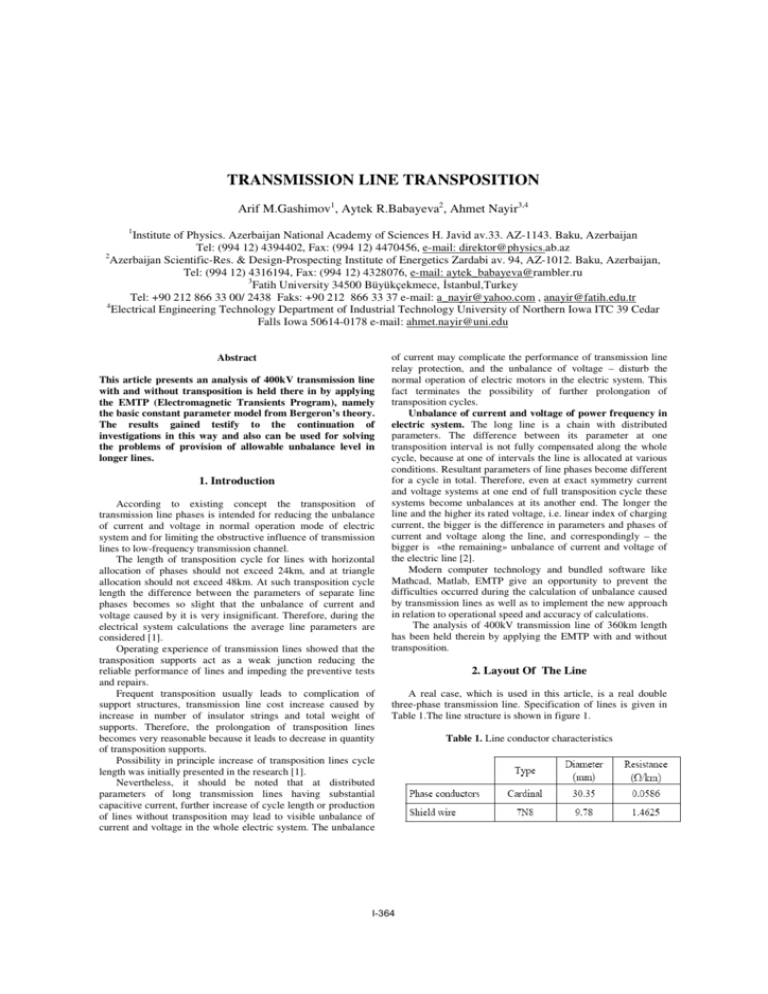
TRANSMISSION LINE TRANSPOSITION Arif M.Gashimov1, Aytek R.Babayeva2, Ahmet Nayir3,4 1 Institute of Physics. Azerbaijan National Academy of Sciences H. Javid av.33. AZ-1143. Baku, Azerbaijan Tel: (994 12) 4394402, Fax: (994 12) 4470456, e-mail: direktor@physics.ab.az 2 Azerbaijan Scientific-Res. & Design-Prospecting Institute of Energetics Zardabi av. 94, AZ-1012. Baku, Azerbaijan, Tel: (994 12) 4316194, Fax: (994 12) 4328076, e-mail: aytek_babayeva@rambler.ru 3 Fatih University 34500 Büyükçekmece, østanbul,Turkey Tel: +90 212 866 33 00/ 2438 Faks: +90 212 866 33 37 e-mail: a_nayir@yahoo.com , anayir@fatih.edu.tr 4 Electrical Engineering Technology Department of Industrial Technology University of Northern Iowa ITC 39 Cedar Falls Iowa 50614-0178 e-mail: ahmet.nayir@uni.edu Abstract This article presents an analysis of 400kV transmission line with and without transposition is held there in by applying the EMTP (Electromagnetic Transients Program), namely the basic constant parameter model from Bergeron’s theory. The results gained testify to the continuation of investigations in this way and also can be used for solving the problems of provision of allowable unbalance level in longer lines. 1. Introduction According to existing concept the transposition of transmission line phases is intended for reducing the unbalance of current and voltage in normal operation mode of electric system and for limiting the obstructive influence of transmission lines to low-frequency transmission channel. The length of transposition cycle for lines with horizontal allocation of phases should not exceed 24km, and at triangle allocation should not exceed 48km. At such transposition cycle length the difference between the parameters of separate line phases becomes so slight that the unbalance of current and voltage caused by it is very insignificant. Therefore, during the electrical system calculations the average line parameters are considered [1]. Operating experience of transmission lines showed that the transposition supports act as a weak junction reducing the reliable performance of lines and impeding the preventive tests and repairs. Frequent transposition usually leads to complication of support structures, transmission line cost increase caused by increase in number of insulator strings and total weight of supports. Therefore, the prolongation of transposition lines becomes very reasonable because it leads to decrease in quantity of transposition supports. Possibility in principle increase of transposition lines cycle length was initially presented in the research [1]. Nevertheless, it should be noted that at distributed parameters of long transmission lines having substantial capacitive current, further increase of cycle length or production of lines without transposition may lead to visible unbalance of current and voltage in the whole electric system. The unbalance of current may complicate the performance of transmission line relay protection, and the unbalance of voltage – disturb the normal operation of electric motors in the electric system. This fact terminates the possibility of further prolongation of transposition cycles. Unbalance of current and voltage of power frequency in electric system. The long line is a chain with distributed parameters. The difference between its parameter at one transposition interval is not fully compensated along the whole cycle, because at one of intervals the line is allocated at various conditions. Resultant parameters of line phases become different for a cycle in total. Therefore, even at exact symmetry current and voltage systems at one end of full transposition cycle these systems become unbalances at its another end. The longer the line and the higher its rated voltage, i.e. linear index of charging current, the bigger is the difference in parameters and phases of current and voltage along the line, and correspondingly – the bigger is «the remaining» unbalance of current and voltage of the electric line [2]. Modern computer technology and bundled software like Mathcad, Matlab, EMTP give an opportunity to prevent the difficulties occurred during the calculation of unbalance caused by transmission lines as well as to implement the new approach in relation to operational speed and accuracy of calculations. The analysis of 400kV transmission line of 360km length has been held therein by applying the EMTP with and without transposition. 2. Layout Of The Line A real case, which is used in this article, is a real double three-phase transmission line. Specification of lines is given in Table 1.The line structure is shown in figure 1. I-364 Table 1. Line conductor characteristics supported. Fig. 3 illustrates a Bergeron specification of a 400kV overhead line given in fig.1. The model is based on the Bergeron’s traveling wave method used by the Electromagnetic Transient Program (EMTP) [3]. In this model, the losses distributed LC line is characterized by two values (for a single phase line): the surge impedance Zc = L / C and the phase velocity υ = 1 / LC . The method can be used to verify if the model is suitable for the typical transients occurring in the study [4]. Fig.1. Phase configuration of transmission line and tower size 2.1 Simulation System The model of untransposed line at phase C closing in ATPEMTP is shown on Figure 2. I V I LC C V LC C V I Fig.2. The model of untransposed line at phase ɋ closing To add a line or cable to the circuit, the user first specifies a 3 phase line/cable model. The input dialog box of this circuit element is shown in fig. 3. In this dynamic dialog box the user specifies if the component is a cable or an overhead line. Then the geometrical and material parameters can be entered under Data. Under Standard data the ground resistivity, the initial frequency and the line/cable length are specified. Finally the user selects the suitable electrical model under Model along with special frequency and fitting data required in each case. It is straightforward to switch between the various electrical models (PI, Bergeron, JMarti, Semlyen and Noda) and ATPDraw handles all the formats, apart from special multiple pi-sections. Only those cases that really produce an electrical model are Fig.3. Line/Cable dialog box. Upper: Selection of system type (line or cable), standard data (grounding and frequency) and Model data (type of model and frequency). Lower: Specification of conductor data Computing results of voltage and current in untransposed line at phase C ground fault are presented on Figure 4, 5. I-365 Fig.7. Voltage value at phase Ⱥ, ȼ, ɋ of transposed line Fig.4. Voltage value of phase Ⱥ, ȼ, ɋ of untransposed line Fig.8. Current value at phase Ⱥ, ȼ, ɋ of transposed line Voltage and current values of phase C with and without transposition are shown on Figure 9, 10. Fig.5. Current value of phase Ⱥ, ȼ, ɋ of untransposed line Taking into account the transposition on Figure 3 it’s necessary to make an addition by noting the transposition: Fig. 9. Voltage value at phase C with and without transposition: 1- without transposition; 2 – with transposition Fig.6. Line/Cable dialog box with transposed Computing results of voltage and current of transposed transmission line at phase C ground fault are shown on Figure 7, 8. Fig. 10.Current value at phase C with and without transposetion: 1- with transposition; 2- without transposition I-366 Phase-to-phase fault of B and C phases with and without transposition has been investigated as well. The model of untransposed line during the phase-to-phase fault of B and C phases in ATP-EMTP is presented on Figure 11. I V SA I LC C V LCC V I Fig.11.The model of untransposed line during the phase-tophase fault of B and C phases in ATP-EMTP Computing results of voltage and current during the phase-tophase fault of B and C phases without transposition are shown on Figure 12, 13. 3. Conclusion At line length of 100km and more the measures should be undertaken for limiting the unbalance in relation to untransposed line. As a rule, the utilization of one cycle of transposition is enough to eliminate the unbalance coefficient up to allowable parameters. When analyzing the transposition scheme it should be considered that the results for classical transposition scheme and simplified transposition scheme will be similar because the extreme phases are allocated symmetrically to average phase, as it was noted in [5]. In lines with horizontal allocation at length exceeding 100km, the usage of line phase transposition is be required. Considering all the aforesaid, the results gained testify to the continuation of investigations in this way and also can be used for solving the problems of provision of allowable unbalance level in longer lines. 4. References [1]. N.N. Mirolyubov On transmission line electrical asymmetri. Proceedings of LPI, #3, 1948 [in Russian]. [2]. M.M.Adibi, D.P.Milanicz, T.L. Volkmann Asymmetry issues in power system restoration. IEEE Trans on Power System, 1999, 14(3):1085-1091. [3]. H.Dommel Digital Computer Solution of Electromagnetic Transients in Single and Multiple Netwoks, IEEE Transactions on Power Apparatus and Systems, Vol PAS-88, No.4, April 1969. [4]. “Alternative Transients Program (ATP) – Rule Book”, Canadian/American EMTP User Group, 1987-1998. [5]. M.V. Kostenko, L.S. Perelman Three-phase aerial line simplest scheme of transposition. Electricity, #8, 1980 [in Russian]. . Fig. 12. Voltage value during the phase-to-phase fault without transposition Fig. 13. Current value during the phase-to-phase fault without transposition I-367


